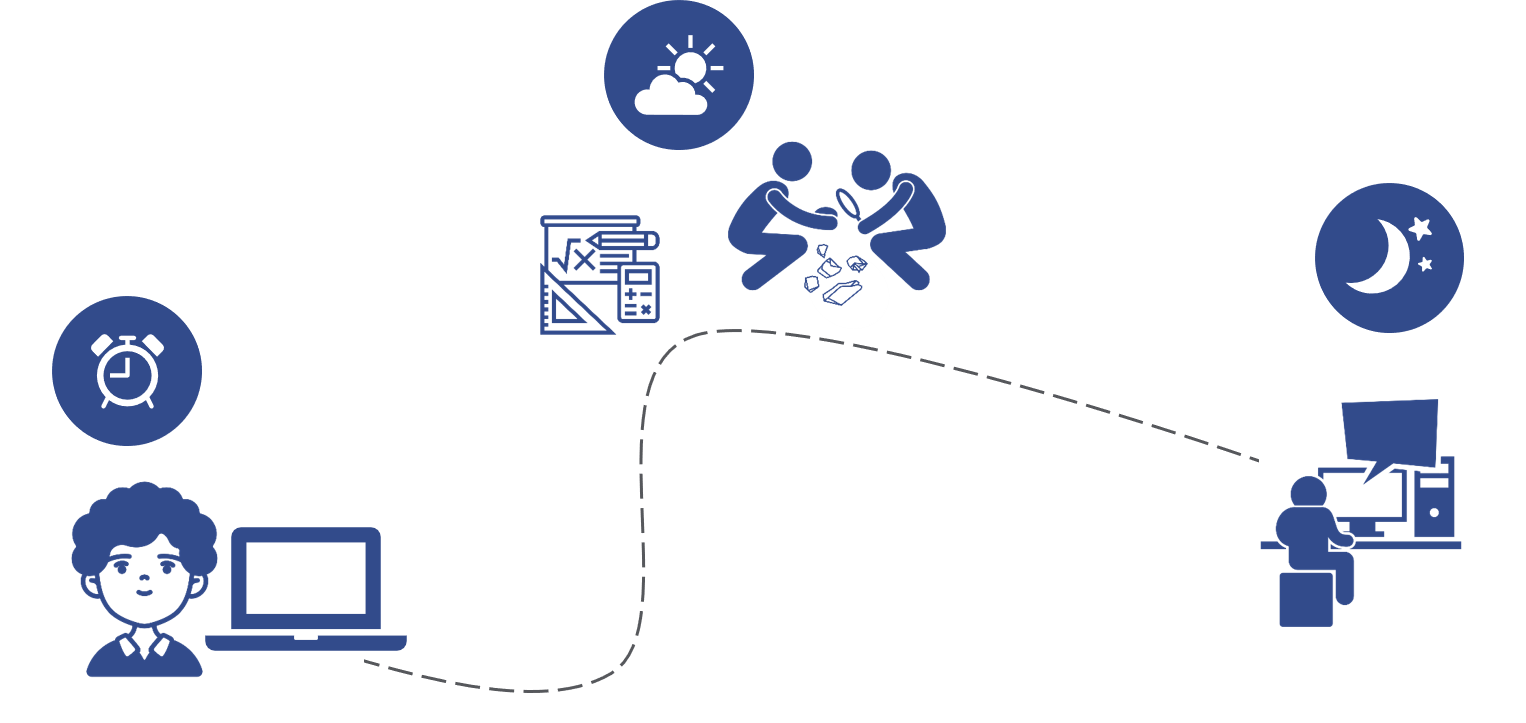This blog is part of a series detailing best practices and key considerations for setting up a high-quality virtual academy, based on research conducted by Education First. This research included a wide-range of sources, including expert interviews from implementers on the ground and research-based best practice. The series discusses: centering the voices of stakeholders at the margins, components of a strong academic strategy and how to build culture and connection in a remote environment. You can see the first blog post here.

Amari wakes up in the morning, eats breakfast and gets ready to start his school day. He sits down in his dining room with his laptop and logs onto Google classroom to connect with his first period math class. His teacher starts with a review of proportional relationships before sending students into breakout rooms to collaborate with each other on a series of problems. At one point his teacher, Mr. Cooley, pops into his breakout room. Mr. Cooley observes the students as they work on a challenging problem and provides them with valuable feedback on their work. Before leaving first period, Amari and his classmates take a three question exit survey through their online portal—the responses in the survey will be used to shape Mr. Cooley’s follow-up support for Amari. After he ends first period, Amari joins two other classes, of which he particularly enjoyed his earth science class where he was able to collect rocks he found in his backyard and his teacher, Mrs. Rivera, taught them how to identify the type of rock. After lunch, Amari engages in asynchronous work for his ELA class that includes time spent reading The Adventures of Tom Sawyer. Once his school day is over, Amari does some homework and is also able to submit any outstanding questions on his assignments. His teachers will assess his homework for learning gains and will use his, and other classmates’ questions, to determine how to support them for tomorrow’s lessons based on the curriculum’s scope and sequence.
More students nationwide will have an educational experience like Amari due to the interest in continuing innovative virtual schools after the 2020–2021 school year. A high quality and innovative learning environment should be predicated upon an academic strategy that is student-centered and equitable. The academic strategy of Amari’s school determined the majority of his school day, particularly how Amari engages with his teachers, classmates and academic content, what he is taught and when, and how he receives feedback. The academic strategy is a virtual academy’s north star that guides a host of other decisions related to scheduling, staffing and student supports.
A virtual academy’s academic strategy will outline what students will learn, how the district will engage students in learning and how the district will know if students learned (ANet). Through our research, we found that there are four key action steps that will support a strong academic strategy:
What students will learn
By selecting high-quality curriculum and instructional materials for virtual academy students, districts can ensure that students who select this educational option are working on rigorous, accessible and engaging grade level material.
1. Choose high-quality curriculum and instructional materials. Using high quality curriculum and instructional materials are a crucial component of a successful virtual academy. ANet’s Four Dimensions of Instructional Materials that Put Students First outlines the dimensions of instructional materials that district leaders should consider as they select high-quality instructional materials. Districts should consider whether the instructional materials and subsequent implementation:
When determining which curriculum and instructional materials to choose, districts should also consider whether they will use the same curriculum used with face-to-face learning or move forward with a different curriculum.
| Lubbock Independent School District, for example, decided to use the same curriculum across the district since they allow students to transition between in-person and virtual learning. Alternatively, Grapevine-Colleyville Independent School District has a full-time online school, iUniversity Prep, as part of the Texas Virtual School Network (TXVSN). In this scenario, students are expected to be enrolled in the online school year-round and can self-pace, therefore their curriculum’s scope and sequence follows a different pace than that of their in-person schools.
“Any of our kids that are virtual are utilizing google classroom, and are staying on the exact same content plan as face to face students. (Students) can enroll in the virtual school at the quarter mark, although if you want to go back to campus you can at any time. You may have a virtual student who tried for three weeks and it doesn’t work. If they go back (in-person) midweek they can jump in for an assessment… and finish out that lesson. This is possible because face-to-face and virtual students follow the same content plan.” —Carry Fulgham, Coordinator of Digital Learning, Lubbock Independent School District |
How a district will engage students in learning
A virtual academy’s academic strategy should be supported by an appropriate Learning Management System that will ease the facilitation of teaching and support students in the remote learning environment.
2. Select a Learning Management System (LMS). A Learning Management System is a robust software application that provides a framework for all aspects of the virtual learning process, from administration and tracking to delivering academic content. Many districts have found an LMS to be a key enabler of their academic strategy as it makes it easier and more seamless for teachers to prepare and execute lessons that are engaging for students. There are a few questions to answer to help select the LMS that works best for the virtual academy’s community, such as:
| Michigan Virtual used a self-hosted LMS as its K12 learning management system for two decades and found it critical to their school’s success. Then, in reviewing their LMS in 2019, they decided they needed to shift to a cloud-based model and therefore began the process of selecting a new LMS. Michigan Virtual now uses Desire2Learn (D2L)’s K-12 Brightspace LMS. You can review this case study outlining the steps that Michigan Virtual took to choose a new LMS system. |
How a district will know if students learned
Establishing grading and feedback policies, as well as strong assessment and data collection systems help a virtual academy address learning needs and maintain a high-quality remote instructional environment.
3. Determine the virtual school’s grading and feedback policies. To maintain a high-quality virtual environment focused on learning and continuous improvement, students need clear and fair grading, work submission and feedback policies. When districts decide what their virtual school’s policy for providing regular, actionable feedback on student work will be, they should consider the following best practices from Instruction Partners:
4. Establish a strong assessment and data collection system. A strong assessment system helps a virtual academy better identify students’ needs and provide them with the support they need to thrive. The tiered data collection system then allows for an efficient and effective process for identifying students’ strengths and needs with greater frequency. When designing the assessment system, districts should consider ANet’s three guiding principles:
Planning for a strong academic strategy is imperative to ensuring a high-quality virtual academy that is academically rigorous, reduces learning barriers and provides students with the academic support they need to thrive. As districts look to continue with remote learning options, they should reflect on what they want their academic strategy to be and ensure they have aligned goals, processes and systems to support that strategy.
| Resources and Tools
Below is a curated list of resources and tools aligned to the four key action steps:
|




